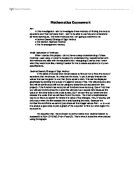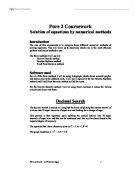In this investigation I aim to investigate three methods of finding the roots to equations and then compare them. I aim to be able to use fully and understand all three techniques.
Mathematics Coursework
Aim
In this investigation I aim to investigate three methods of finding the roots to equations and then compare them. I aim to be able to use fully and understand all three techniques. The three methods that I am going to examine are:
?Decimal Search/Change of Sign Method
?The Newton-Raphson Method
?The Re-arrangement Method.
Initial Exploration of Methods
When I started this project I did not have a deep understanding of these methods I was using. In order to develop my understanding I experimented with the methods and also with the equations that I was going to use so that I knew what they would look like, making it easier for me to create equations to my own specifications.
Decimal Search/Change of Sign Method
In the piece of course work we are asked to find (or not to find) the roots of equations that we choose. But what are the roots. To put it simply they are the values that can be given to x so that f(x) is equal to zero. This can be displayed graphically by plotting the values of x against values of f(x). This will produce a line that will be continuous (will not be using any discontinuous equations in this project). If the function has roots (not all functions have roots e.g. f(x)=x2+5) then you will see the line cross the x-axis this will occur as x equals zero because the value on the other axis at the x axis is zero. So if we can find out where the line crosses the x-axis then we will have found the roots. The most unsophisticated way to do this is to search for where the value of f(x) changes. This, of course, will only occur when the line crosses the x-axis locating the roots. Because the number line is infinite we cannot just check all the integer values from -? to ? so it is always a good idea to plot a graph of the equation to find out what region it's roots are in.
The equation that I have chosen to demonstrate how Decimal Search is successful is f(x)=10*SIN(0.2*x)+x2-sqrt(2). This is what it looks like when plotted using Omnigraph.
Aim
In this investigation I aim to investigate three methods of finding the roots to equations and then compare them. I aim to be able to use fully and understand all three techniques. The three methods that I am going to examine are:
?Decimal Search/Change of Sign Method
?The Newton-Raphson Method
?The Re-arrangement Method.
Initial Exploration of Methods
When I started this project I did not have a deep understanding of these methods I was using. In order to develop my understanding I experimented with the methods and also with the equations that I was going to use so that I knew what they would look like, making it easier for me to create equations to my own specifications.
Decimal Search/Change of Sign Method
In the piece of course work we are asked to find (or not to find) the roots of equations that we choose. But what are the roots. To put it simply they are the values that can be given to x so that f(x) is equal to zero. This can be displayed graphically by plotting the values of x against values of f(x). This will produce a line that will be continuous (will not be using any discontinuous equations in this project). If the function has roots (not all functions have roots e.g. f(x)=x2+5) then you will see the line cross the x-axis this will occur as x equals zero because the value on the other axis at the x axis is zero. So if we can find out where the line crosses the x-axis then we will have found the roots. The most unsophisticated way to do this is to search for where the value of f(x) changes. This, of course, will only occur when the line crosses the x-axis locating the roots. Because the number line is infinite we cannot just check all the integer values from -? to ? so it is always a good idea to plot a graph of the equation to find out what region it's roots are in.
The equation that I have chosen to demonstrate how Decimal Search is successful is f(x)=10*SIN(0.2*x)+x2-sqrt(2). This is what it looks like when plotted using Omnigraph.







